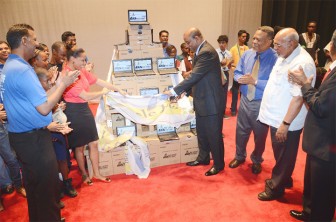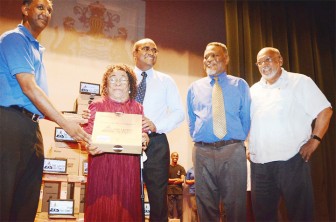Some 1,000 families from across the country yesterday received computers as the initial distribution began under government’s One Laptop Per Family (OLPF) project.
The allotment, part of the 5,000 netbooks which arrived in the country recently, was distributed to a select group of persons from various parts of the country at a gathering at the National Cultural Centre.

President Bharrat Jagdeo said that the project “opens a whole lot of possibilities” for the Guyanese family, while noting that the administration will be delivering on its promise to connect each family to the internet, allowing persons to be able to complete a range of technology-related processes without leaving the home. “We can deliver education right into the homes; without leaving the home, persons can access any government service, E–government, health, education and security,” he said. He added that the sectors will be totally modernised and will have computerised records of the populace.
Globally, he noted, technology has removed the physical borders between countries and people can communicate with each other in remote locations across the world. At the same time, he said there is also the perception that within a country some persons may be more fortunate than others where access to technology is concerned. “And that is the gap we are fearful of …where people may not be able to connect to the outside world,” he added.
Jagdeo said that the information communication and technology (ICT) sector has great potential for the future of Guyana, while adding that it is poised to transform the economy. “You will be part of the process. This is why I see this not as just an equipment; I see it as the beginning of a partnership, between government and citizens of country,” he said.
The president noted that the administration’s immediate goal is to ensure that within the next three years, every Guyanese is computer literate and he noted that while the focus today is on the youths to be fully computer-literate, the overall aim of the project is to ensure that every Guyanese is able to use the computer.

He said that the fibre optic cables being laid from Brazil and another along the coastline will aid the process. Jagdeo noted that while the administration has criticised telecommunications company Guyana Telephone and Telegraph (GT&T) in the past, it is working in a partnership with the company to boost the ICT sector by providing added connectivity to the country.
At the beginning it will not be broadband, he noted and connectivity will come at lower speeds. But he said that this will increase over time with the larger projects being undertaken across the country.
According to the OLPF secretariat, another 4,000 laptops will be distributed this week via the HUBs created in the various communities across the country. An additional 10,000 laptops will arrive in the country within the week.
Jagdeo urged the recipients not to sell the computers, noting that the project is a billion dollars of possibilities with government’s support. “Some things will go wrong, couple of people might sell theirs and we don’t want that, we have people picking at dead flesh,” he added, keeping up with his theme of labelling critics as vultures and carrion crows.
Meantime, he noted that the Haier company will be moving ahead with a plan to establish a plant to assemble computers in Guyana in the not too distant future. He said that the company will also be assembling appliances and the items will be sold around the Caribbean.
The OLPF is the brainchild of President Jagdeo, according to the OLPF Secretariat and it is aimed at developing the country’s ICT sector. It has been at the centre of debate, as some critics view the project as an election gimmick.
However, the government has maintained that the project focuses on bridging the digital divide and enhancing community and economic development.
Critics have said that better options would be to provide all teachers with laptops or to equip each child with a laptop within the school setting. Questions have been raised about maintenance of the equipment, theft, reliability and cost of internet connections and ultimately what the laptops will be used for.




